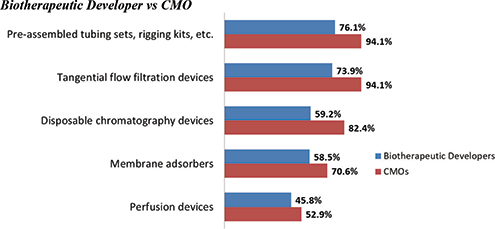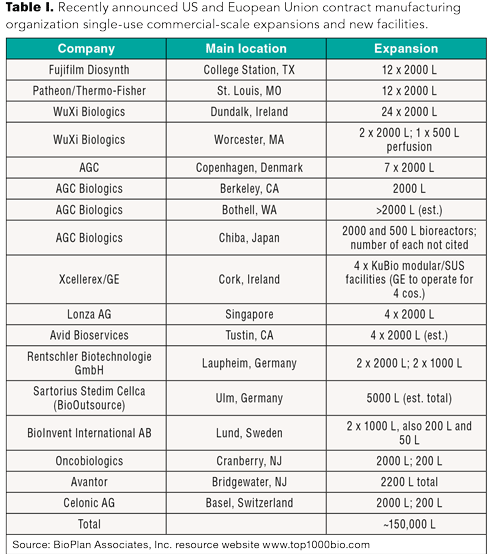CMOs Leading the Way on Single-Use Systems Adoption
Single-use systems can be a cost savings for CMOs, and these savings can be passed on to clients and, ultimately, to patients.
Contract manufacturing organizations (CMOs) are on the constant lookout for better single-use systems for their clients. By a relatively wide margin, CMOs have implemented novel single-use systems sooner than therapeutic developers (innovators). This is because CMOs stay competitive when they produce biologics, particularly for R&D and clinical trials, more efficiently and cost effectively (1).
For example, in BioPlan Associates’ 15th Annual Report and Survey of Biopharmaceutical Manufacturing, which included responses from 222 biopharmaceutical manufacturers and CMOs in 22 countries and 130 bioprocessing suppliers or vendors, tangential flow filtration devices are used by 94% of CMOs but only 73.9% of the biotherapeutic developers (Figure 1). Similar results are shown for novel devices such as membrane adsorbers, disposable chromatography, and perfusion devices.
Figure 1. Applications in biopharmaceutical manufacturing; percent using single-use products. [Figure courtesy of the authors]

BioPlan surveys conducted during the past 15 years have found the trend of adopting single-use equipment continues, with CMOs leading the way. Single-use equipment, particularly for upstream manufacture (e.g., bioreactors), now dominates small- to mid-scale, R&D, and clinical trial manufacture, while fixed stainless-steel equipment continues to dominate commercial manufacturing.
Total capacity for single-use devices
In the BioPlan survey, respondents were asked about the adoption of SUS and about facilities’ total single-use capacity. In volume, 17% of respondents noted that their largest single-use bioreactor capacity was 1000 L, suggesting late-stage clinical or commercial manufacturing, and 2000 L was the maximum at 14% of facilities. Approximately one-third of respondents reported facilities had single-use bioreactors with more than 1000 L capacity (i.e., working at large scale by single-use standards). As expected, few facilities (2.3%) had single-use bioreactors with greater than 2000-L capacity. However, this percentage is expected to increase in coming years.
Currently, 500–2000 L is often cited as the optimal or most cost-effective bioreactor size for pre-commercial-scale manufacture in mammalian systems, including monoclonal antibodies (mAbs). This range allows for the use of single-use equipment. But single-use equipment has only begun to be adopted for commercial product manufacture, and the current scale for SUS bioreactors, generally limited to 2000 L, is still too small for most commercial antibody production, unless multiple bioreactors are used. While a few facilities, especially CMOs, run multiple 2000-L bioreactors together, large-sized fixed stainless-steel equipment continues to dominate commercial mAb manufacture.
Few mainstream commercial mAb products are manufactured using single-use bioprocessing systems. This is expected to change, however, over the next few years as products currently in the development pipeline using smaller scale single-use systems are approved and enter the market. To get there, FDA and regulatory agencies in developed countries will need to see that product manufacturing using single-use devices is safe, and that mAbs produced this way can be comparable to traditional mAb products. Further, many in the industry continue to expect that manufacture in stainless tanks will generally be more cost effective for large-volume liquids.
Single-use capacity growth among CMOs
A growing number of established mainstream bioprocessing CMOs worldwide-and especially in the United States and Europe-are adding commercial manufacturing capacity involving single-use bioreactors in the 1000–2000-L or greater range, generally in one or more 2000-L bioreactor-based process lines (Table I). In addition, specialized CMOs are bringing cell- and gene-therapy facilities online.
Table I. Recently announced US and Euopean Union contract manufacturing organization single-use commercial-scale expansions and new facilities.

Only a few years ago, the industry could boast of single-use bioreactor sizes up to only 1000 L. Now most companies offer bioreactor sizes up to 2000 L, and some are offering 4000-L single-use bioreactors.
CMOs are generally involved with more diverse products than innovator companies, and generally prefer single-use systems for the flexibility and fast changeover time. In addition, the full cost is often passed on to the client. But CMOs are reporting more issues with purification than developers. Innovator companies generally have more time and latitude to optimize downstream bioprocessing, because they develop and scale-up fewer products in-house; development time can be a decade or more. It is not surprising that CMOs responding to the BioPlan survey generally expressed higher interest than developers in single-use products, because single-use equipment provides the flexibility and rapid turnaround they require.
Single-use and modular manufacturing
Single-use equipment and manufacturing technologies continue to improve, and more modular bioprocessing facilities are entering the market. These advancements are enabling developing regions-such as Brazil and Thailand-to increasingly manufacture for their own domestic needs including commonly used vaccines with or without the participation of original product developers and current manufacturers. Cuba has been manufacturing diverse biopharmaceuticals for itself and international commerce for some time.
Accommodating multiple products in a single plant is a typical way to increase facility utilization, and single-use technologies such as disposable buffer/product bags, drug substance bags, and flow path assemblies for chromatography and ultrafiltration/diafiltration enable quick transition from product to product.
In addition, a facility designed as a shell with reconfigurable space, similar to a nonclinical pilot plant, allows rapid reconfiguration to accommodate a wide range of process sequences. To achieve this, the processes, equipment, and automation must be designed to be highly productive in small, portable modules that can be easily rearranged to enable rapid changeover. Modular designs are enabling plant operators to easily switch between different types of equipment to make different products. Combined modular and single-use technologies reduce investment and operating costs, as well as the financial risk of building new manufacturing facilities. The benefits of this approach, including enhanced quality control, reduced waste, reduced impact on current operations, and simplified site logistics, are leading to a significant change in the design of the next generation of manufacturing facilities.
Improvements are expected in the physical/mechanical properties of single-use products and how these products are manufactured and supplied, with a deeper understanding of how they interact with processes and ultimately with patients. These improvements will occur not just for bioreactors but for other critical components like flow paths, filtration, and chromatography, which still lag behind cell culture in terms of capacity. Future opportunities to expand the application base for single use will arise with the introduction of new therapeutic modalities or novel ways of manufacturing established products. Cell culture-based vaccines, highly potent antibody-drug conjugates, bispecific antibodies, antibody fragments, and gene and personalized therapies will involve unique production challenges.
Single-use systems can provide cost savings; sometimes these savings can be substantial compared with fixed stainless-steel systems, particularly larger systems. However, as in previous surveys, direct cost savings did not appear to be the primary factor for decision-makers. The data indicate that users of disposable systems are as concerned or more concerned about factors that will save time (add speed), reduce risk and processing disruptions, increase flexibility, and accelerate campaign turnaround. They are also interested in reducing capital equipment.
As the industry matures, vendors are introducing technologies such as improved single-use films/bags, sensors, chromatography systems, and mixers to differentiate themselves from the competition. This bodes well for customers, as competition may drive down prices and create more options to choose from. Recent advances continue in the area of single-use bioreactors where the size and scale of the vessels are increasing along with their automation.
Single-use systems can save on facility and campaign costs for CMOs, which in turn can reduce operating costs and capital investments. The flexibility and quick turnaround times between process runs and client projects allowed by single-use equipment can also improve efficiency, which can reduce costs. These savings can be passed on to clients and, ultimately, to patients. Such savings also increase the perception of the cost-savings associated with contract manufacturing and potentially increase CMO profits.
Reference
1. Langer, E.S., et al., 15th Annual Report and Survey of Biopharmaceutical Manufacturing Capacity and Production, BioPlan Associates, April 2018.
Article Details
Pharmaceutical Technology
Vol. 43, No. 3
March 2019
Pages: 58–60
Citation
When referring to this article, please cite it as I. Roizman and E. Langer, "CMOs Leading the Way on Single-Use Systems Adoption," Pharmaceutical Technology 43 (3) 2019.

Drug Solutions Podcast: A Closer Look at mRNA in Oncology and Vaccines
April 30th 2024In this episode fo the Drug Solutions Podcast, etherna’s vice-president of Technology and Innovation, Stefaan De Koker, discusses the merits and challenges of using mRNA as the foundation for therapeutics in oncology as well as for vaccines.